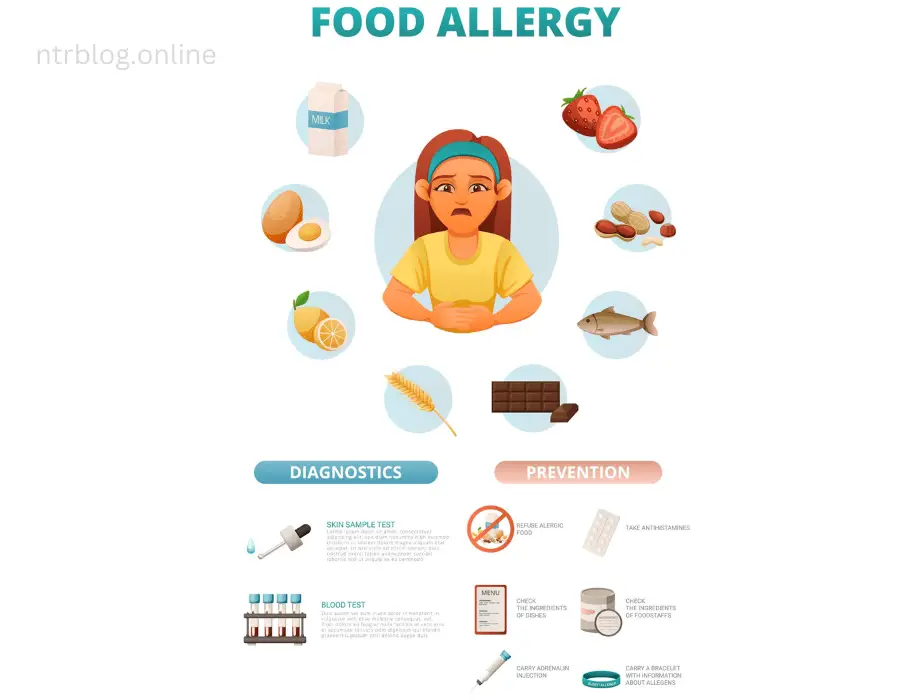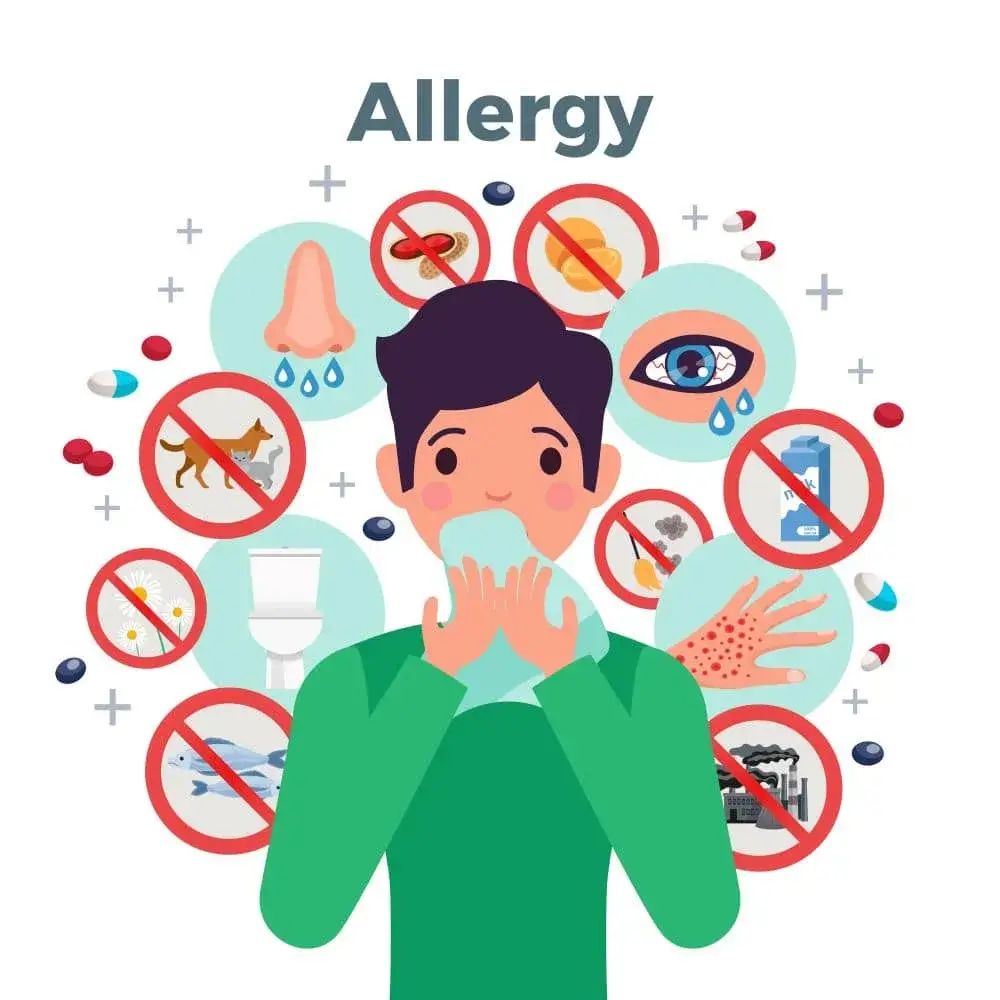Overview:
What exactly are food allergies?
- Food allergies appear when the body’s immune system overreacts to specific proteins in certain foods. This exaggerated reaction is called an allergic reaction.
Table of Contents
Different types of food allergies:
- Food allergy can arise from a variety of sources. However, most food allergies, about 90%, are associated with eight primary types of food:
- eggsfishMilkGroundnutshellsoy
- tree nuts
- wheat
How prevalent are food allergy?
- Statistics show that more than 50 million Americans struggle with food allergy. Among adults, about 4% of people struggle with food allergies, while in children this figure rises to 6%.
Effect of food allergy on the body:
- Normally, the immune system functions to recognize and eliminate harmful pathogens. In the case of food allergy, the immune system misidentifies the food protein as a threat. An allergic reaction is triggered when it comes in contact with this protein.
Differentiating allergy from intolerance:
- It is important to note the difference between food allergy and food intolerance. Allergies trigger an immune system response and can be life threatening. In contrast, intolerance produces a reaction in the digestive system. Individuals with intolerances can tolerate small amounts of the problematic food without experiencing serious symptoms. While intolerances can be uncomfortable, they usually do not pose a life threat.
Symptoms and causes of food allergy:
Understanding the reasons:
- Food allergy often have a hereditary component, usually running in families. People suffering from other allergic conditions like hay fever or eczema are more likely to experience food allergies. Similarly, people suffering from asthma are also at higher risk of food allergies.
Recognizing Allergic Reactions:
- Food allergy symptoms usually appear within two hours of consuming the triggering food. The range of symptoms can vary in intensity from mild to severe. Allergic reactions may include:
- Hives or skin rash
- swelling of lips or eyelids
- Itching in the mouth, throat, or swelling of the tongue
- hoarse voice or difficulty swallowing
- Coughing, wheezing or trouble breathing
- stomach pain, vomiting or diarrhea
- dizziness or loss of consciousness
Risk of serious reactions:
- The most serious and life-threatening reaction to a food allergy is anaphylaxis. Anaphylaxis is a rapid reaction that causes shock within the body, potentially leading to difficulty or obstruction of breathing. Without prompt medical intervention, anaphylaxis can pose a serious threat to life.

Diagnosis of food allergy:
Identifying Food Allergy Triggers:
- Food allergy usually produce persistent reactions whenever you consume the triggering food. Healthcare providers establish the diagnosis by asking about the following:
- Time taken for symptoms to appear
- Details about the type and amount of suspected trigger food ingested
- Nature and duration of the symptoms experienced
Clinical testing for confirmation:
- Health care professionals specializing in allergy and immunology use a variety of tests to confirm food allergy. One common method is a skin test, in which your healthcare provider:
- Administers small amounts of different allergens (allergy-causing substances) onto your skin, usually on the arms or backThese allergens cause small pricks or scratches
- Observe reactions on the skin after about 15 minutes; Redness and itching in specific areas indicate an allergic reaction, which helps identify the specific allergen.
- Additionally, radioallergosorbent blood testing (RAST) may be employed. This test assesses the level of allergic antibodies to various allergens in your bloodstream. Elevated levels of specific antibodies may indicate the presence of allergies to specific substances.
Management and Treatment of Food Allergies:
Treatment Approaches:
- Upon identifying specific foods that trigger allergic reactions, the primary strategy involves strictly avoiding these foods. It is essential to have emergency medications, such as epinephrine autoinjectors, readily available in case of accidental ingestion and subsequent reaction. It is important to seek immediate emergency medical help after using an epinephrine autoinjector. It is also advisable to wear medical alert identification detailing your food allergies.
Medications for allergic reactions:
- Healthcare providers may prescribe medications aimed at reducing the symptoms of an allergic reaction, including:
- Epinephrine (for example, EpiPen® or Auvi-Q), an essential emergency medicine that quickly responds to the symptoms of anaphylaxis.
- -Antihistamines, which reduce itching or congestion.
- Corticosteroids to reduce inflammation in case of a severe allergic reaction.
Avoiding Triggers:
- To avoid allergy-causing foods, careful checking of ingredient labels on food products is essential. Food manufacturers are required to clearly indicate the presence of the eight most common food allergens on labels.
- Some labels may include cautionary statements such as “may contain” or “made on shared devices.” If uncertainty persists regarding food choices, it is recommended to consult your healthcare provider for guidance.
Prevention of food allergies:
- Currently, there is no surefire way to prevent food allergies in adults. However, in infants, breastfeeding during the first six months of life may help prevent milk allergies. Including highly allergenic foods such as peanut proteins and eggs in the diet in the early stages can potentially have a preventive effect. It is important to discuss these strategies with your healthcare provider for personalized guidance.
Outlook and Forecast:
- It is entirely possible to live a healthy life with food allergy. Management of food allergies requires strict avoidance of all triggering foods and ingredients. Depending on dietary restrictions, nutritional supplements may be necessary to replenish any lost nutrients. Before making significant changes to your diet, it is advisable to consult your healthcare provider or registered dietitian.
Living with Food Allergies:
Demand for medical help:
- Consult a healthcare provider if consumption of specific foods causes uncomfortable symptoms. Diagnosis and proper treatment are important to effectively manage food allergies.
Emergency Moment:
- Life-threatening allergic reactions require immediate medical attention. Go to the emergency room or dial 911 if you encounter:
- Difficulty in breathing
- chest tightness
- widespread hives
- Tingling feeling in hands, feet or lips
- Swelling of the throat causes narrowing of the airways.
conclusions:
- Food allergies, which are characterized by the body’s exaggerated immune response to specific proteins in certain foods, affect millions of individuals in various age groups. Understanding the causes, symptoms, and potentially life-threatening effects of food allergies is paramount for effective management.
- While precise prevention of food allergies in adults remains elusive, strategies such as introduction of allergy-causing foods to infants and breastfeeding during the early months of life seem promising in reducing the risk of certain allergies.
- Living with food allergies requires strict avoidance of trigger foods, preparedness with emergency medications like epinephrine autoinjectors, and prompt medical attention if allergic reactions are experienced. Clear communication with healthcare providers and adherence to personalized diet plans are essential for individuals living with food allergies.
- Despite the challenges, it is possible to live a healthy life by actively managing food allergies, following dietary restrictions, seeking professional guidance, and staying alert in emergency situations. Empowering yourself with knowledge, precautions, and quick action forms the foundation for effectively living with and managing food allergies.

FAQs.
Q. What is a food allergy?
A. Food allergies occur when the immune system reacts abnormally to specific foods, mistaking them for harmful substances. This reaction triggers a range of symptoms that can range from mild to severe and affect different parts of the body. Allergy symptoms result from an overreaction of the immune system to certain proteins in foods, affecting the skin, gastrointestinal tract, respiratory system, or even causing anaphylaxis, a serious and potentially life-threatening condition. Is a life-threatening reaction.
Q. How many types of food allergies are there?
A. Virtually any food can cause allergies, but eight types of food cause about 90% of food allergies. These are common allergies:
1. Eggs
2. Fish
3. Milk
4. Peanuts
5. Conch
6. Soy
7. Tree Nuts
8. wheat
However, individuals may also be allergic to other foods in addition to these primary eight allergens.
Q. How many Americans are struggling with food allergies, according to statistics.?
A. Statistics show that more than 50 million Americans struggle with food allergies. Among adults, about 4% of people struggle with food allergies, while in children, the prevalence can reach 6%.


